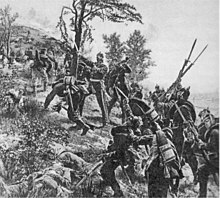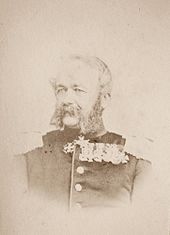Bruno by François
Bruno Hugo Karl Friedrich von François (born June 29, 1818 in Magdeburg , † August 6, 1870 in Spicheren ) was a Prussian major general .
Life
origin
He was the son of the later Prussian Lieutenant General Karl von François (1785–1855) and his wife Betty, née Vangerow (1799–1844).
Military career
François attended the pedagogy in Halle and the grammar schools in Koblenz , Cologne and Luxembourg . On December 29, 1834, he joined the 37th Infantry Regiment of the Prussian Army as a musketeer , which at that time was commanded by his father. There he was promoted to secondary lieutenant in January 1836 and from October 1, 1839 he was sent to the General War School for three years for further training . In the further course of his military career, François took part in the war against Denmark in 1864. On January 4, 1866, he was commissioned to lead infantry regiment No. 58 and on April 3, 1866, he was appointed regiment commander. As such, François became a colonel on June 8, 1866 , and in the same year fought against the Austrians at Nachod , Skalitz , and Schweinschädel . In the battle of Königgrätz he was wounded on July 3, 1866 and awarded the order Pour le Mérite on September 20, 1866 .
In position à la suite of his regiment, François was charged with the command of the 27th Infantry Brigade on July 14, 1870 and promoted to major general on July 26, 1870 . Five days later he was appointed commander of this brigade with which he went to war against France . As brigade commander, François commanded the Lower Rhine Fusilier Regiment No. 39 and the Hanoverian Infantry Regiment No. 74 on August 6, 1870 at the Battle of Spichern . Shortly after he had reached the plateau of the Spicherer Heights after storming the Red Mountain, he was hit under the raised right arm and collapsed. Hit by four more bullets by precision shooters, he died. Apparently his last words were: “It's a beautiful death on the battlefield; I like to die seeing that the battle is going on. "
The place of his death, which is fenced in and has a memorial stone, is in the immediate vicinity of the memorial for the 1st Hanoverian Infantry Regiment No. 74. His grave is in the cemetery of the German-French Garden in Saarbrücken.
The grave inscription reads: “He was hit by five enemy bullets in the victorious approach when he stormed the Spichernberge on August 6th, 1870. Horses are prepared for the days of battle, but the victory comes from the Lord. Spr. Salm. 21.31 "
family
On August 13, 1847 he married in Luxembourg from Koblenz Dating Marie Amalie Helene von Wentzel (1829-1909), a daughter of Lieutenant General Wilhelm von Wentzel . The marriage had six children:
- Karl Wilhelm Bruno (1848–1850)
- Alfred Karl Bruno (* December 2, 1849; † June 22, 1911), major general ⚭ 1892 Elisabeth Luise Erdmuthe Emilie von Petery (* October 20, 1863)
- Olga Maria Friederike (1851–1879)
- Curt (1852–1931), officer of the German protection force in the colony of German South West Africa and founder of Windhoek ⚭ Amalia Gereses, 1896–1911 ⚭ Margarethe Meyer zu Bohmte (born July 17, 1880)
- Hermann (1856–1933), Prussian general of the infantry ⚭ Elisabeth Emma Olga von Besser (born March 30, 1859)
- Hugo (1861–1904), officer of the German protection force in German South West Africa ⚭ Else Goedecke
Commemoration

In depictions of the Franco-Prussian War, the action of General von François in the Battle of Spichern was very often portrayed as a heroic deed and his death as a heroic deed beyond its strategic importance . A large painting by Anton von Werner from 1880 shows how François, standing next to a trumpeter, encourages his soldiers to storm the Red Mountain during the Battle of Spichern. The painting is part of the “ Saarbrücken City Hall Cycle ”, which includes two other paintings by Werner with scenes from the battlefield and four portraits of people and was given to the city of Saarbrücken by the Kingdom of Prussia . The paintings were in a specially built, hall-like extension of the former town hall, today's Old Town Hall , on Saarbrücken Castle Square . The annex, which was used as a meeting and ballroom, was destroyed in the heavy bombing raid on Saarbrücken on October 5, 1944. However, the pictures could be saved and were then stored in the St. Johann town hall . They are now privately owned.
In 1895, to commemorate the 25th anniversary of the battle, the sculptor Wilhelm Schneider modeled two life-size statues based on the image detail showing François and the trumpeter. The group of figures "Von François with trumpeter" was set up as a provisional plaster model in front of the mine management in St. Johann and then brought to the St. Johann Volksgarten, where it stood for many years and, exposed to the weather, deteriorated over time. At an unknown point in time, the remains were removed. The execution of a similar monument made of galvanized cast bronze failed due to the question of costs and the question of a possible participation of the city of St. Johann in the financing of the project.
The memorial path to the memorials on the Spicherer Heights is named after Bruno von François.
literature
- Carl Bleibtreu : Battle of Spichern on August 6, 1870 . Reprint of the 1903 edition. Rockstuhl Verlag , Bad Langensalza 2009, ISBN 978-3-86777-071-2 .
- Kurt von Priesdorff : Soldier leadership . Volume 8, Hanseatische Verlagsanstalt Hamburg, undated [Hamburg], undated [1941], DNB 367632837 , p. 242ff., No. 2580.
- Saarwald-Verein eV (ed.): Excursions over the Spicherer heights. Heroism and heroic death on the Red Mountain. Bruno von François and Schultze-Katrin . Saarbrücken 2001, pp. 19-24.
- Wulf Wein: There has long been peace over the graves . In: Saarbrücker Zeitung (supplement "Heimat") from 29./30. May 2010, p. H 4.
- Gothaisches genealogisches Taschenbuch der Briefadeligen houses, 1907, first year, p.188
Individual evidence
- ^ Kurt von Priesdorff: Soldatisches Führertum. Volume 5, Hanseatische Verlagsanstalt Hamburg, undated [Hamburg], undated [1938], DNB 367632802 , p. 384, no. 1609.
- ^ The Franco-German War 1870–71, edited by the war history department of the Great General Staff. Volume I, 1, ES Mittler & Sohn , Berlin 1872, p. 327.
- ↑ Prov 10: 1-22, 16 EU
- ↑ Klaus Dierks : BIOGRAPHIES OF NAMIBIAN PERSONALITIES V. Accessed August 31, 2015 .
- ↑ Dominik Bartmann : The Saarbrücken town hall cycle. In: Dominik Bartmann (Ed.): Anton von Werner. Story in pictures. Hirmer Verlag , Munich 1993, ISBN 3777461407 , pp. 252-265.
- ^ Gerhild Krebs: Old Town Hall Saarbrücken. memotransfont, accessed August 24, 2013 .
- ↑ Rainer Knauf, Christoph Trepesch: war memorials and war cemeteries. Forms of war memorial in the Saarbrücken area between 1870 and 1935. In: Lieselotte Kugler (Hrsg.): Grenzenlos. Worlds of life in the Franco-German region on the Saar and Moselle since 1840. Historisches Museum Saar, Saarbrücken 1998, ISBN 3-9805574-1-3 , pp. 156–182.
| personal data | |
|---|---|
| SURNAME | François, Bruno von |
| ALTERNATIVE NAMES | François, Bruno Hugo Karl Friedrich von (full name) |
| BRIEF DESCRIPTION | Prussian major general |
| DATE OF BIRTH | June 29, 1818 |
| PLACE OF BIRTH | Magdeburg |
| DATE OF DEATH | August 6, 1870 |
| Place of death | Save |





